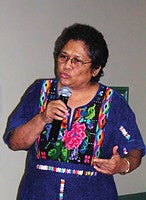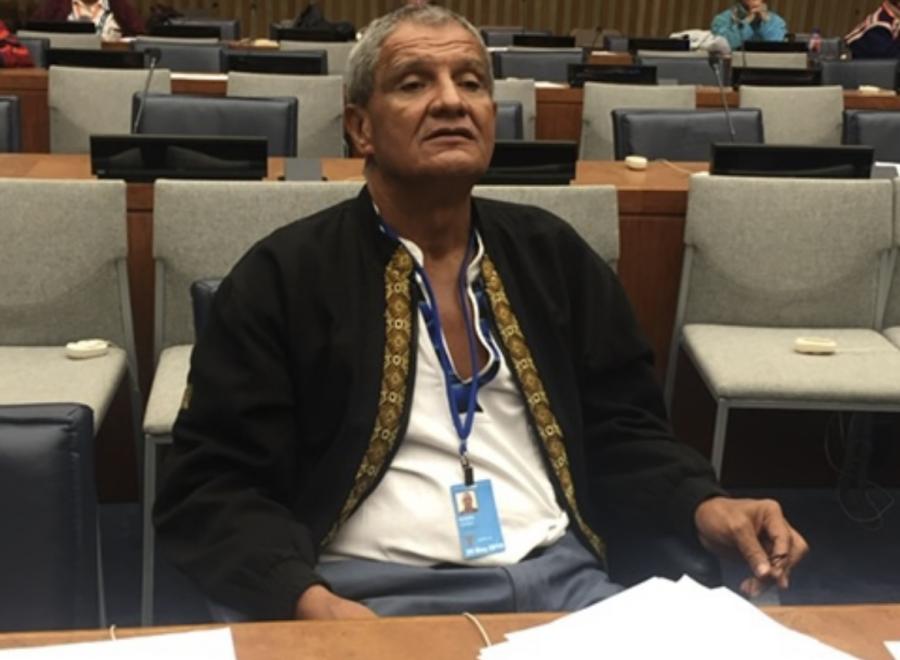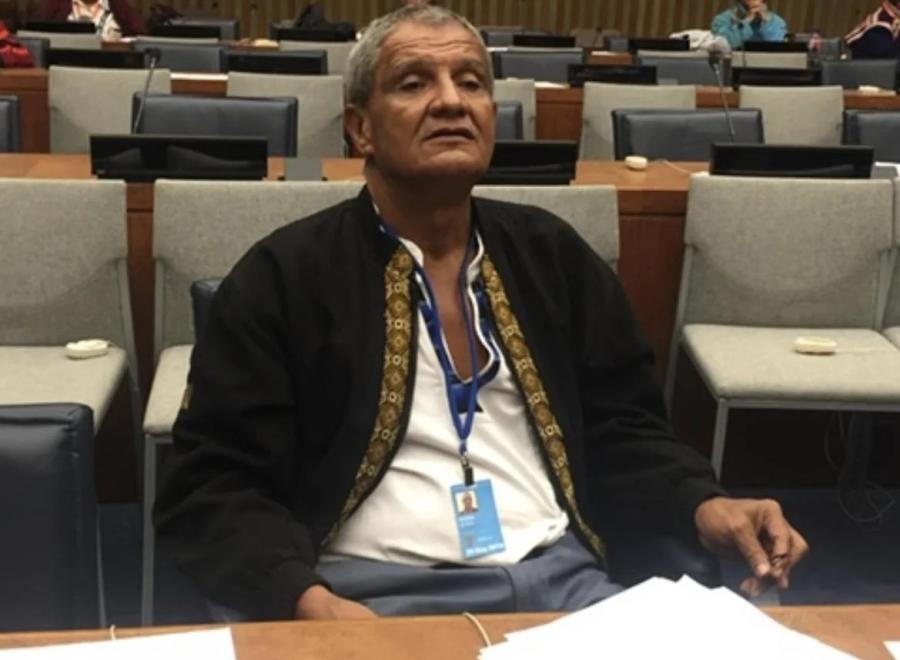 Mirna Cunningham addresses an audience about Indigenous rights. Photo courtesy of Mirna Cunningham.Mirna Cunningham founds organizations and collects titles the same way many people write in their personal journals: passionately and often. A Miskito woman based in Nicaragua, she has served as executive secretary of the Inter-American Indian Institute in Mexico, general secretary of the Inter-American Indigenous Institute, and was awarded the Pan American Health Organization’s Public Health Heroine of the Americas Award in 2002. Currently Cunnningham is the director of the Center for Indigenous Peoples’ Autonomy and Development and vice-president of the Indigenous Initiative for Peace, and her work spans a range of issues, from human rights to education to health care.
Mirna Cunningham addresses an audience about Indigenous rights. Photo courtesy of Mirna Cunningham.Mirna Cunningham founds organizations and collects titles the same way many people write in their personal journals: passionately and often. A Miskito woman based in Nicaragua, she has served as executive secretary of the Inter-American Indian Institute in Mexico, general secretary of the Inter-American Indigenous Institute, and was awarded the Pan American Health Organization’s Public Health Heroine of the Americas Award in 2002. Currently Cunnningham is the director of the Center for Indigenous Peoples’ Autonomy and Development and vice-president of the Indigenous Initiative for Peace, and her work spans a range of issues, from human rights to education to health care.
But Cunningham did not start as an advocate for Indigenous rights. She was trained as a physician and was on track to pursue a purely medical career, serving as Nicaragua’s only Indigenous Miskito doctor and the medical director of the Bilwaskarma Clinic. Then in 1981, during the Sandinista conflict, she was kidnapped outside the hospital by Contra forces and taken to their training camp in Honduras, where she was raped and beaten. She was eventually returned to Nicaragua with the warning not to practice in that area any more—they did not want doctors in the Atlantic coastal region, in which they carried out many operations. That proved the turning point in her becoming an advocate for Indigenous rights. Three years later, after the defeat of the Contras, Cunningham became the Minister of Government for Northern Zelaya, which became the North Atlantic Autonomous Region (RAAN) in 1987. She served as a member of the National Assembly from 1990 to 1997, playing a crucial role in representing the interests of a state largely populated and run by Miskito people. She has also wielded political influence as the director of research and chair for the RAAN in the Nicaraguan Ministry of Health.
Cunningham’s transition from physician to advocate is one she views as natural: “I see health as a very important component of the culture, of the development of rights in an Indigenous community,” she says, “because health has to do with maintaining balance, with maintaining the equilibrium inside the community.” The management of health in an Indigenous community, Cunningham says, has a lot to do with equality and the worldview of that community. State and private agencies providing health services within Indigenous groups “usually only use a very minimal part of the knowledge that the communities have on health,” she says, which makes the health sector prime “for building capacity in a community, for changing the relation between a community and the state.”
And although Cunningham admits that it still needs work, she believes that the “intercultural health system model” being implemented in the autonomous regions of Nicaragua serves as a step towards effectively reorganizing the health-care system. “We are defining what we understand as primary health care in an intercultural context,” Cunningham says. This includes hearing the voices of those ignored under the current health-care and political systems. “I think health is an area though which the states can really respect Indigenous Peoples’ rights, but it cannot be implemented if there is not a real recognition of Indigenous Peoples,” says Cunningham.
Cunningham sees the Indigenous Peoples of Latin America as applying two specific strategies in the struggle for this recognition: “contextual autonomy” and “building a more professionalized relationship between Indigenous communities and the states.”
The first strategy is about “the development of Indigenous Peoples’ own capacity in their jurisdiction, if it’s an autonomous region, in their own context. This means development of capacity with a holistic approach; they are trying to develop capacity in their health system, in their education system, in the management of their lateral resources, in the management of their territory, in the administration of justice.”
The second strategy, Cunningham says, depends on teaching Indigenous Peoples to negotiate for their rights, but also means “teaching the governments to understand how to respect the recognition of collective Indigenous rights.” The two autonomous regions of Nicaragua, RAAN and RAAS (South Atlantic Autonomous Region), are prime examples of how a “contextual autonomy” for Indigenous Peoples can be achieved within a mutually respectful relationship with the government.
But a holistic approach to Indigenous rights includes more than just working within the health care system. Cunningham is currently developing the Intercultural Indigenous University of Latin America, a network of more than 20 universities that all share “some kind of commitment to Indigenous Peoples.” This network aims to improve the capacity of Indigenous leaders, but, Cunningham stresses, it is not exclusive to the education and autonomy of Indigenous communities.
“I don’t think that when we use the term ‘Indigenous education,’” she says, “we are thinking only to educate, to inform ourselves, to govern ourselves in our communities. I think we are talking about a paradigm shift in the ways in which education has been organized in the past, in which colonization and racism have been part of that education. I think that when we say ‘Indigenous education’ we are trying to change that paradigm, and we are trying to shift towards something that can help not only Indigenous communities but also help other people.”
Cunningham believes that by creating an educational system that supports a collaborative way of living, rather than merely reproducing the “oppression” of the established educational system, we may achieve a peaceful future between Indigenous Peoples and the current social institutions that largely ignore their knowledge and their needs.
As part of this innovative educational system, the university is currently trying to develop a new program to improve the capacity of Indigenous women. Gender can play a crucial role in the way Indigenous Peoples perceive and fight oppression, says Cunningham: “Indigenous women face a different type of oppression. Although we are all Indigenous people facing external oppression, sometimes the internal oppression that women face makes it much more difficult for women to participate. Usually the mixed organizations, men and women, are struggling together to advance the rights of the community as a whole, but sometimes women’s rights are invisible in that context.”
By advancing women’s rights within Indigenous communities, Cunningham believes, women will be able to contribute more to the external struggle for Indigenous rights. But, she argues, fighting for Indigenous women’s rights need not be confined to their individual communities. “Indigenous women,” she says, “have a chance to organize from the local level onto the international level, and there is a very strong movement of Indigenous women in different parts of the world trying to let their voices be heard.” As a founding member of MADRE and a board member of the Global Fund for Women, two international women’s advocacy organizations, Cunningham is working towards this global recognition of women’s rights.
A comprehensive approach is evident in all of her work, because Cunningham believes it is essential to creating “a future in which we and they can live together.”
Sarah Cadorette is a student at Emerson College and an intern at Cultural Survival.



